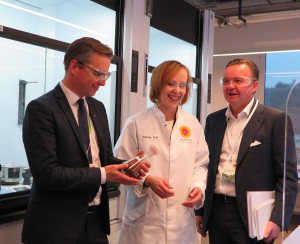Inaugurated in Stockholm, Sweden, late last year, the new Stora Enso Innovation Centre for Biomaterials will support the company in identifying new business opportunities and facilitate partnership agreements with other nearby facilities, so to accelerate the launch of new solutions.
Stora Enso, a global provider of renewable solutions for the packaging, biomaterials, wood and paper industries with head offices in Stockholm and Helsinki, has recently inaugurated a new Innovation Centre for Biomaterials in the Swedish capital city. The facility already employs 40 people but by the end of 2017 it should host 100 professionals at least. Opened at the presence of the Swedish Minister for Enterprise and Innovation Mikael Damberg, the plant aims to identify new business opportunities for bio-based products, as the company stated, as well as to strengthen the links between Stora Enso’s expertise and the skills displayed by other research centers, universities, business partners. The company’s goal is therefore to accelerate «the development of bio-based products from wood and other non-food competing feedstock», as Kirsi Seppäläinen, Senior vice president for Communications at Stora Enso’s Biomaterials department told Paper Industry World. «The Centre», Seppäläinen observed, «is an important step of our transformation into a renewable materials company and it is building upon our forestry tradition and fibres expertise to help the company produce second-generation bio-based chemicals and biomaterials for customers in various industries and markets. It will facilitate knowledge-sharing and collaboration between employees and boost the firm’s ability to discover new business opportunities. It also allows us to partner up with other leading research centres in order to ensure renewable products a faster time to market».

What role will the Centre play, in Your opinion, in the development of new services and products for the paper, printing and packaging industries worldwide, Mrs. Seppäläinen?
«It enables us to find new ways to use biomass and develop new technologies, looking forward to responding to our customers’ needs and diversifying Stora Enso’s product portfolio. Indeed, some of these materials can be addressed to the packaging industry: the company already produces lignin, which can be used for coatings and adhesives. Finally, our goal is to work on innovating our pulp products offer, to serve the needs of such clients as the tissue, hygiene and textile industries.»
How is the Centre going to support and address the paper, printing and packaging sectors?
«Of course, paper has traditionally been one of Stora Enso’s largest market segments and still represents an important part of its business. However, given the decrease in paper demand and the increasing customers’ request for more sustainable products, Stora Enso has shifted its focus towards biomaterials. By providing a range of packaging solutions, we are now in a strong position, at the very heart of a booming sector. The traditional pulp-making process uses around 50% of the tree. The rest, such as lignin and hemicellulose, is usually burned for energy. New technologies are enabling us to extract hemicellulose, sugars and lignin from biomass more efficiently. The new business platform focuses on a more effective usage of raw materials and on producing second-generation bio-chemicals and biomaterials. The Centre plays a crucial role in this transformation.»
Can You foresee a growth in the demand for biomaterials in the paper industry worldwide?
«Population growth, urbanisation, climate change and resource scarcity are some of the megatrends driving the demand for biomaterials, in the paper industry and beyond. To tackle these challenges and address the demand, Stora Enso Biomaterials has four innovation clusters to transform non-food-competing, non-GMO biomass feedstock. The first one deals with pulp applications, including tissues, paper, hygiene, textile and non-woven, packaging and speciality fibres. The second focuses on cellulose modification, lignin applications and on adding value to pulp by-products, thus opening new markets. The third aims at developing the extraction technology platform to produce C5 and C6 sugars and lignin; while the fourth targets the transformation of sugars into value-added bio-based chemicals. Stora Enso is targeting the pulp, cellulosic and intermediates markets and also sees growth opportunities in the areas of packaging solutions, consumer board and wood construction.»
Which countries are driving the global demand for traditional paper and biomaterials?
«While the demand for traditional paper is decreasing in the US and in Western Europe, consumption is growing in Asia as well as in other developing nations. For such biomaterials as bio-based chemicals, the fastest growing markets today are Europe, the Asia-Pacific region and, again, the United States. The request for fibre-based packaging is rocketing worldwide, supported by an impressive increase in online purchasing. Stora Enso believes that the future is bio-based and that, therefore, bio-based products will increasingly replace a wide number of fossil fuel-based items.»
What are Your company’s most important international markets today and which ones could emerge as the most promising in the short or medium term, Mrs Seppäläinen?
«When it comes to paper, wood and packaging, Stora Enso’s focus is on growth markets in China, India, Pakistan and Latin America. However, traditional home markets in the Nordics and Europe still remain important for the company. Recent Stora Enso investments in biomaterials include new or improved facilities in the United States and in the Scandinavian countries. In 2014, Stora Enso acquired US biotechnology firm Virdia, to test the fractionation technology of fibres, lignin and hemicellulose. Former Virdia’s technology will be used to extract and separate high-purity sugars from biomass in a demonstration plant based in Raceland, Louisiana. The facility will produce xylose, a five-carbon (C5) sugar derived from sugarcane bagasse. Xylose can be transformed into xylitol, which is commonly and widely used in food and oral care applications. Stora Enso’s new lignin separation technology is helping its mill in Sunila, Finland reduce its carbon emissions and thus start the commercialisation of lignin. Our lignin production processes came online in 2015.»
Could You finally give us an example of the benefits and advantages that Stora Enso’s biomaterial-based solutions managed to offer Your customers, in recent times?
«The Stora Enso Biomaterials division has developed a bio-refinery concept which is able to efficiently extract glucose and lignin from a high-purity xylose sugar stream, as well as byproducts such as tall oil and turpentine. This kind of biomaterials can be used in a wide range of industries, including the packaging, construction and joinery segments. Stora Enso’s Consumer Board division has also developed bio-polyethylene (or: Bio-PE) and biopolymer solutions as renewable alternatives to oil-based plastics in the food packaging arena. In fact, Stora Enso’s biopolymers are mostly made from renewable materials and are completely compostable.»

